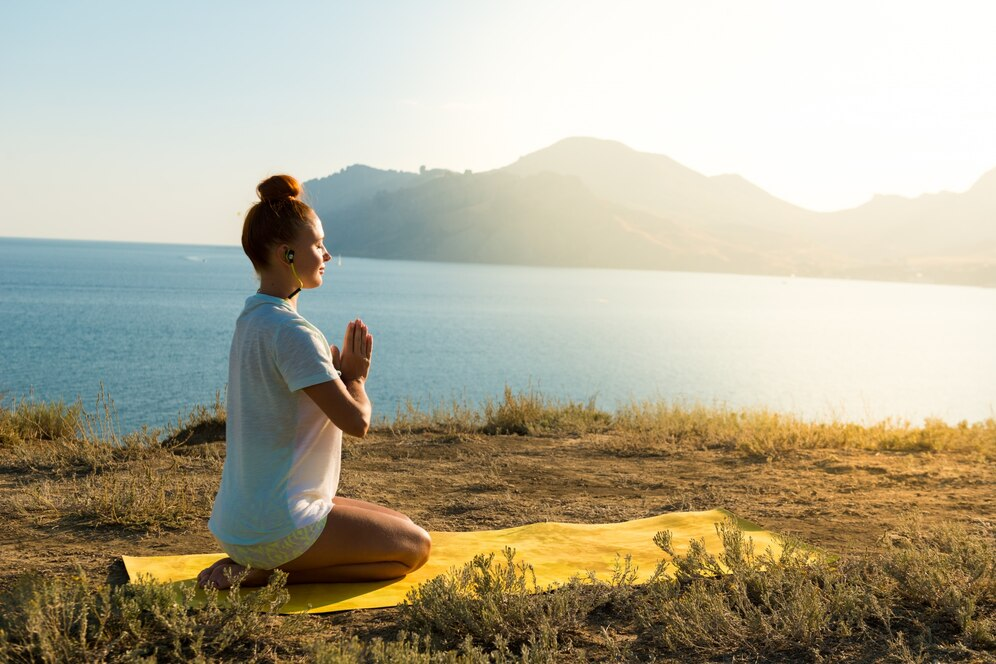Between work deadlines, social obligations, and the constant buzz of technology, it can be difficult to find a moment of peace. But what if we told you that a calm mind wasn’t a luxury, but a necessity?
Maintaining a calm mind unlocks a treasure trove of benefits. You’ll experience improved focus, better decision-making, and increased resilience to stress. You’ll also find yourself sleeping better, having stronger relationships, and enjoying life more fully.
The good news is, that achieving a calm mind isn’t about achieving some mystical state of zen. It’s about incorporating small, practical strategies into your daily routine. So, put down that overflowing coffee mug, take a deep breath, and let’s explore how to create your oasis of calm.

Understanding Your Stress Response
Before we dive into calming techniques, let’s take a quick detour to understand how stress works in our bodies. When we face a perceived threat, our body goes into “fight-or-flight” mode. This primal response releases hormones like adrenaline and cortisol, which prepare us to take action.
While this response was helpful for our ancestors facing a saber-toothed tiger, it’s not exactly ideal for dealing with a looming deadline or a traffic jam. Chronic stress can lead to a cascade of health problems, including anxiety, depression, and even heart disease.
The key to a calm mind lies in managing this stress response. By incorporating calming techniques, we can signal to our bodies that it’s safe to relax, and gradually shift out of that fight-or-flight state.
Simple Strategies to Cultivate a Calm Mind
Now, let’s get down to the practical stuff! Here are five simple strategies you can incorporate into your daily routine to cultivate a calmer mind:
1. Mindfulness Meditation:
Meditation gets a lot of hype, but for good reason. It’s a practice of training your attention to focus on the present moment without judgment. There are many different meditation techniques, but a simple one for beginners is mindfulness meditation.
Here’s how to do it: Find a quiet place to sit comfortably. Close your eyes or soften your gaze. Focus on your breath, feeling the rise and fall of your chest with each inhalation and exhalation. When your mind wanders (and it will!), gently guide your attention back to your breath. Start with just a few minutes a day and gradually increase the duration as you become more comfortable.
There are many free meditation apps available, such as Headspace and Calm, which can guide you through different types of meditation.
Deep Breathing Exercises: Breathe Your Way to Calm
Deep breathing exercises are a cornerstone of stress management techniques for a reason. They offer a simple, yet powerful way to activate your body’s relaxation response. When you take slow, deep breaths, you signal to your nervous system that it’s safe to unwind. This, in turn, leads to a cascade of benefits, including:
- Slower heart rate: Deep breathing helps to slow down your racing heart, often a key symptom of stress and anxiety.
- Lower blood pressure: As your heart rate slows, your blood pressure naturally dips, reducing strain on your cardiovascular system.
- Reduced stress hormones: Deep breathing helps to regulate the production of cortisol, the primary stress hormone.
- Improved focus and concentration: By calming the mind and body, deep breathing can enhance your ability to concentrate and think clearly.
Here’s a breakdown of a simple deep breathing exercise you can do anywhere, anytime:
1. Find Your Comfort Zone:
Start by sitting or lying down in a comfortable position. You can choose a chair with good back support, lie flat on your back on a yoga mat, or even sit on a park bench. The key is to find a position where you can breathe deeply without restriction.
2. Belly Breathing:
Most people tend to breathe shallowly, using their chest muscles. Deep breathing, however, engages your diaphragm, the large muscle that separates your chest cavity from your abdominal cavity. To ensure you’re using your diaphragm, place one hand on your chest and the other on your belly. As you inhale slowly through your nose, feel your belly inflate, pushing your hand outwards. Your chest should remain relatively still.
3. The Power of the Pause:
Once you’ve filled your belly with air, hold your breath for a count of one or two (don’t strain!). This brief pause allows for a more complete exchange of gas in your lungs.
4. Slow and Steady Exhalation:
Now comes the release. Purse your lips slightly and exhale slowly and steadily through your mouth, feeling your belly deflate as the air leaves your lungs. Imagine you’re blowing out a birthday candle.
5. Repeat and Refine:
Continue this cycle of deep inhales through your nose, pauses, and slow exhales through your mouth for several minutes. As you practice, you can gradually increase the length of your inhalations and exhalations. Aim for a comfortable rhythm that feels calming and relaxing.
Bonus Tip: Enhance your deep breathing experience by incorporating visualization. As you inhale, imagine you’re drawing in peace and serenity. As you exhale, visualize stress and tension leaving your body with each breath.
Progressive Muscle Relaxation: Melt Away Tension, One Muscle Group at a Time
Progressive muscle relaxation (PMR) is another powerful technique to combat stress and anxiety. It works by systematically tensing and relaxing different muscle groups in your body. This process helps to release physical tension that often builds up during stressful situations. By focusing on the sensations of tension and relaxation, you train your mind to recognize and release physical tension associated with stress.
Here’s a step-by-step guide to practicing PMR:
1. Find Your Sanctuary:
Create a calm and quiet environment where you won’t be disturbed. Dim the lights, put on some relaxing music (optional), and ensure a comfortable temperature. Lie down on a yoga mat or a comfortable bed, or sit in a supportive chair.
2. Center Yourself:
Take a few moments to close your eyes or soften your gaze. Focus on your breath, taking a few slow, deep breaths as described in the previous section. This will help you center yourself and prepare your body for relaxation.
3. The Tension-Relaxation Cycle:
We’ll begin with your toes. Start by clenching the muscles in your toes as tightly as you comfortably can, hold for a count of five, feeling the tension build in your feet. Now, release the tension completely, focusing on the feeling of relaxation that washes over your toes. Take a deep breath in as you tense, and exhale slowly as you release.
4. Working Your Way Up:
Repeat this process of tensing and relaxing for different muscle groups throughout your body, working your way up in a systematic manner. Here’s a suggested sequence:
- Lower Legs: Tense your calf muscles, hold, then release.
- Thighs: Squeeze your quadriceps, hold, then release.
- Glutes: Clench your buttocks, hold, then release.
- Stomach: Tighten your abdominal muscles, hold, then release.
- Chest: Take a deep breath in, hold your chest puffed out, then exhale and release the tension.
- Back: Squeeze your shoulder blades together, hold, then release.
- Arms: Tense the muscles in your forearms, hold, then release. Repeat for your biceps and upper arms.
- Neck and Shoulders: Shrug your shoulders up towards your ears, hold them, then let them drop down. Slowly roll your head in a circular motion, feeling the tension release in your neck muscles.
- Face: Scrunch up your face, hold, then release. Tighten your jaw, hold, then release.
5. Savor the Relaxation:
Once you’ve completed the sequence for your entire body, take a few moments to simply lie or sit there, basking in the feeling of deep relaxation. Notice how your body feels heavy and calm.
Practice Makes Perfect: The more you practice PMR, the more effective it becomes. Aim to practice for 15-20 minutes daily, or even break it down into shorter sessions throughout the day. With regular practice, you’ll develop the ability to identify and release tension in your body quickly and effectively, helping you manage stress and anxiety naturally and healthily.

Additional Practices for Lasting Calm
The five strategies above are a great starting point for cultivating a calm mind. However, for lasting peace, consider incorporating these additional practices into your life:
Prioritize Sleep:
When you’re well-rested, you’re better equipped to handle stress. Aim for 7-8 hours of quality sleep each night. Establish a regular sleep schedule, create a relaxing bedtime routine, and make sure your bedroom is dark, quiet, and cool.
Nourish Your Body:
What you eat has a big impact on your mood and stress levels. Choose a balanced diet rich in fruits, vegetables, whole grains, and lean protein. Limit processed foods, sugary drinks, and excessive caffeine, which can worsen anxiety and disrupt sleep.
Move Your Body:
Regular exercise is a fantastic stress reliever. It releases endorphins, which have mood-boosting effects and help to burn off stress hormones. Find an activity you enjoy, whether it’s walking, running, dancing, swimming, or yoga. Even a short burst of exercise can make a difference.
Practice Gratitude:
Taking time to appreciate the good things in your life can have a powerful calming effect. Start a gratitude journal and write down a few things you’re grateful for each day. You can also try a gratitude meditation, where you silently focus on things you appreciate in your current moment.
Challenge Negative Thoughts:
Our thoughts play a big role in how we feel. When we get stressed, our minds tend to jump to worst-case scenarios. Challenge these negative thoughts by asking yourself if they’re realistic. Try to reframe negative thoughts into more positive and realistic ones.
Connect with Loved Ones:
Strong social connections are essential for our mental well-being. Spending time with loved ones who make you feel supported and cared for can help to buffer the effects of stress.
Pursue Creative Activities:
Engaging in creative activities like painting, writing, playing music, or gardening can be a great way to de-stress and express yourself.
Limit Caffeine and Alcohol:
While caffeine and alcohol may provide a temporary sense of calm, they can worsen anxiety and disrupt sleep in the long run.
Cultivating a calm mind is a journey, not a destination. There will be days when stress and anxiety creep in. The key is to be gentle with yourself and practice these calming techniques regularly. The more you practice, the easier it will become to manage stress and find your inner oasis of calm.
If you’re struggling to manage stress on your own, there’s no shame in seeking professional help. A therapist can teach you additional coping mechanisms and help you develop a personalized plan for managing stress and anxiety.

